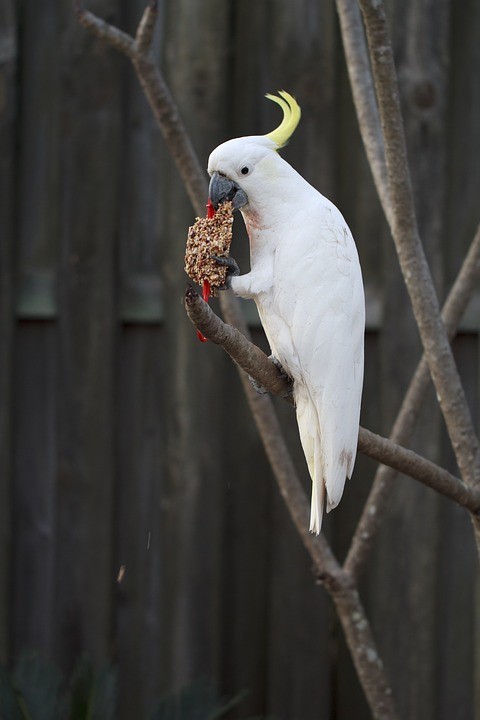White Cockatoo
A species of White Cockatoos and Corellas, Also known as Umbrella Cockatoo Scientific name : Cacatua alba Genus : White Cockatoos and Corellas
White Cockatoo, A species of White Cockatoos and Corellas
Also known as:
Umbrella Cockatoo
Botanical name: Cacatua alba
Genus: White Cockatoos and Corellas
Content
Description General Info
Description
The white cockatoo is around 46 cm (18 in) long, and weighs about 400 g (14 oz) for small females and up to 800 g (28 oz) for big males. The male white cockatoo usually has a broader head and a bigger beak than the female. They have brown or black eyes and a dark grey beak. When mature some female white cockatoos can have reddish/brown irises, while the irises of the adult male are dark brown or black. The feathers of the white cockatoo are mostly white. However, both upper and lower surfaces of the inner half of the trailing edge of the large wing feathers are a yellow color. The yellow color on the underside of the wings is most notable because the yellow portion of the upper surface of the feather is covered by the white of the feather immediately medial (nearer to the body) and above. Similarly, areas of larger tail feathers that are covered by other tail feathers – and the innermost covered areas of the larger crest feathers – are yellow. Short white feathers grow from and closely cover the upper legs. The feathers of this species and others create a powder similar to talcum powder that easily transfers to clothing. In common with other cockatoos and parrots, the white cockatoo has zygodactyl feet with two toes facing forward and two facings backward, which enable it to grasp objects with one foot while standing on the other, for feeding and manipulation. The maximal lifespan of the white cockatoo is poorly documented. A few zoos report that they live 40–60 years in captivity. Anecdotal reports suggest it can live longer. Lifespan in the wild is unknown but believed to be as much as ten years less. 
Size
46 cm
Life Expectancy
40-60 years (captivity), 30-50 years (wild)
Nest Placement
Cavity
Feeding Habits
White Cockatoo predominantly feed on arboreal seeds and fruits. They showcase unique foraging techniques like bark-peeling in search of insects. These birds have a distinct dietary adaptation for extracting food from hard-to-reach places.
Habitat
The white Cockatoo, typically resides in flat or gently sloping areas within primary and selectively logged lowland rainforests. Preferring elevations below 600 meters, their habitat is characterized by dense forest canopies and a high biodiversity of plant life. These habitats span broad geographical regions in tropical zones where lush, green vegetation and a warm, moist climate support their ecological needs.
Dite type
Omnivorous
General Info
Feeding Habits
Bird food type
Distribution Area
Cacatua alba is endemic to lowland tropical rainforest on the booty islands of Halmahera, Bacan, Ternate, Tidore, Kasiruta and Mandioli (Bacan group) in North Maluku, Indonesia. Records from Obi and Bisa (Obi group) are thought to be introductions. It occurs in primary, logged, and secondary forests below 900m. It also occurs in mangroves, plantations including coconut and agricultural land. Cacatua alba is endemic to the islands of Halmahera, Bacan, Ternate, Tidore, Kasiruta and Mandiole in North Maluku, Indonesia. Records from Obi and Bisa are thought to reflect introductions, and an introduced population breeds locally in Taiwan. It remains locally common: in 1991–1992, the population was estimated at 42,545–183,129 birds (Lambert 1993), although this may be an underestimate as it was largely based on surveys from Bacan and not Halmahera where the species may have been commoner. Recent observations indicate that rapid declines are on-going, and are predicted to increase in the future (Vetter 2009). CITES data show significant harvest rates for the cage bird trade during the early 1990s. Annual harvests have declined in actual terms and as a proportion of the remaining population in recent years, but illegal trade continues and is likely to have been underestimated (S. Metz in litt. 2013) There are established populations of these birds currently present in Florida.[1] 
Species Status
The white cockatoo is considered Endangered by the IUCN. Its numbers in the wild have declined owing to capture for the cage bird trade and habitat loss. It is listed in appendix II of the CITES list which gives it protection by restricting export and import of wild-caught birds. BirdLife International indicates that catch quotas issued by the Indonesian government were 'exceeded by up to 18 times in some localities' in 1991, with at least 6,600 umbrella cockatoos being taken from the wild by trappers – although fewer birds have been taken from the wild in recent years, both in numerical terms and when taken as a proportion of the entire population. RSPCA supported surveys by the Indonesian NGO ProFauna suggest that significant levels of trade in wild-caught white cockatoos still occur, with 200+ taken from the wild in north Halmahera in 2007. Approximately 40% of the parrots (white cockatoo, chattering lory, violet-necked lory and eclectus parrot) caught in Halmahera are smuggled to the Philippines, while approximately 60% go to the domestic Indonesian trade, especially via bird markets in Surabaya and Jakarta. The illegal trade of protected parrots violates Indonesian Act Number 5, 1990 (a wildlife law concerning Natural Resources and the Ecosystems Conservations). 
